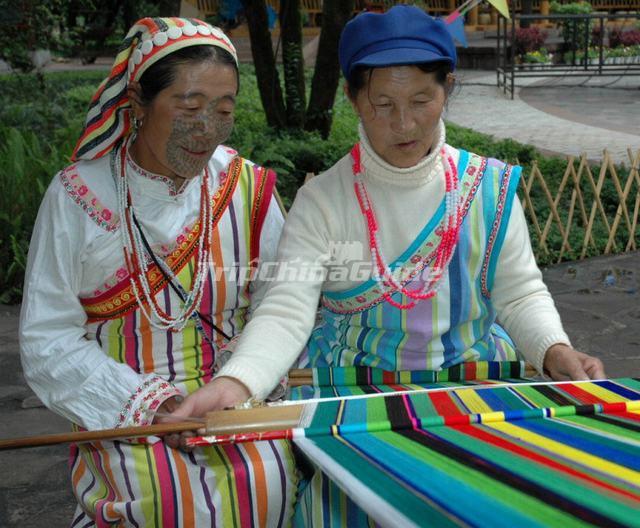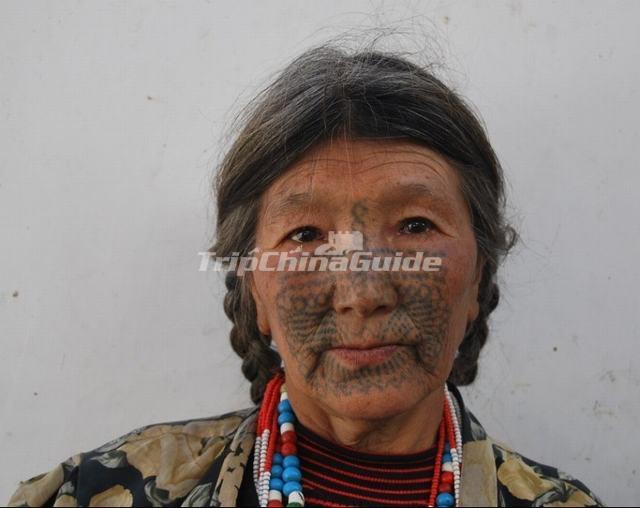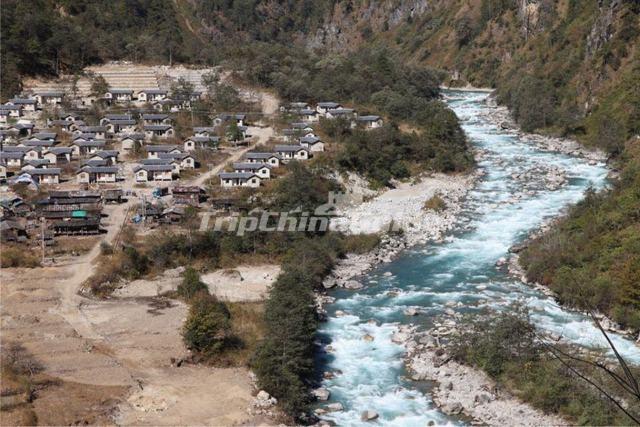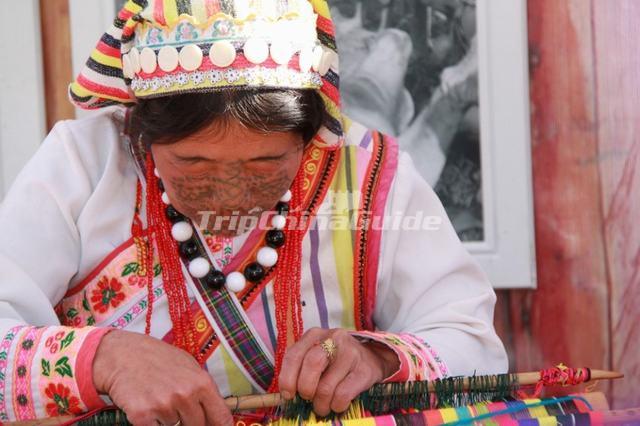Drung Ethnic Group
The Drung people are the 5th smallest of the 56 ethnic groups officially recognized by the government after the founding of the PRC. The Drung people also called "Qiu people" in historical records, it still remain the patriarchal clan commune of the late primitive society.
Population
6,930 (2010)
Main Areas Inhabited by Drung
The Drungs, numbering about 6,930 is found in the Nujiang Autonomous Prefecture of Yunnan province, in the Dulong valley. Another 600 can be found east of the Dulong valley, living in the mountains above the Nu Jiang (Salween River) near the village of Binzhongluo in northern Gongshan County.
Language
Their language belongs to the Tibetan-Myanmese group of the Chinese-Tibetan language family. Similar to the language of the Nu people, their neighbors, it does not have a written form and, traditionally, records were made and messages transmitted by engraving notches in wood and tying knots.
History
During the Tang Dynasty (618-907), the places where the Drungs lived were under the jurisdiction of the Nanzhao and Dali principalities. From the Yuan Dynasty (1271-1368) to the end of the Qing Dynasty (1644-1911), the Drungs were ruled by court-appointed Naxi headmen. In modern times, the ethnic minority distinguished itself by repulsing a British military expedition in 1913.
Natural Environment
The Dulong River valley extends 150 km from north to south. It is flanked on the east by Mt. Gaoligong, 5,000 meters above sea level, and on the west by Mt. Dandanglika, 4,000 meters above sea level.
The area has abundant rainfall due to the influence of monsoon winds from the Indian Ocean; the annual precipitation is 2,500 mm. Virgin forests cover the mountain slopes, and medicinal herbs, wild animals and mineral deposits abound. Crops grown in the area used to be limited to maize, buckwheat and beans, but after liberation at the mid-20th century rice and potatoes were introduced.
Society and Economy
Before the founding of the People’s Republic of China in 1949, Drung society maintained many vestiges of the primitive commune system. There were 15 patriarchal clans called "nile." Each nile consisted of several family communes, and each commune occupied a separate territory marked off by boundaries such as streams and mountain ridges. The clan was further divided into "ke'eng," or villages, where people dwelt in common long houses.
Agricultural production remained at a very low level until 1949, due mainly to the primitive nature of the Drungs' farm tools. Every year saw several lean months when their diet had to be supplemented by food gathering, hunting and fishing.
The ke'eng members pursued collective farming on common land and held their hunting, fishing and gathering grounds in common. However, in modern times this system was slowly giving way to ownership of the means of production by blood-related families. Following financial difficulties due to illness or debt as a result of the imposition of taxes, land sales gradually led to the emergence of oppressive landlords. And rich households used to make seasonal workers and destitute children work for them.
The Drungs produced some primitive handicrafts, including bamboo and rattan articles and engaged in the weaving of linen. But the absence of both traders and towns made barter the only form of exchange.
The ke'eng was the grassroots organization of Drung society. Its members regarded themselves as being descended from the same ancestor. A Drung's personal name was preceded by that of the family and his father's name. In the case of a woman, her mother's name was included.
Each ke'eng was headed by a "kashan" whose duties were both administrative and ceremonial. He also directed warfare and mediated disputes. The ke'eng people were politically separate entities, which formed temporary alliances in times of great danger threatening from outside communities.
Marriage
Marriage within the clan was forbidden and monogamy was the rule in recent times, but vestiges of primitive group marriage remained, such as several sisters marrying one man. Polygamy was also not unknown.
Funeral
The dead were buried in the ground in hollow logs, except in cases of death from serious disease, when the corpses were cremated or disposed of in the rivers. Funerals were attended by all the relatives, who brought sacrificial offerings of food.
Clothing
The Drung people, male and female, wear their hair down to their eyebrows in front and down to their shoulders behind. Both sexes used to wrap themselves in a covering of striped linen fastened with straw ropes or bamboo needles. The poorer ones would often have no other clothing but a skirt of leaves.
Girls tattooed their faces at the onset of puberty, with the patterns varying according to the clan.
Building
The traditional ke'eng long house -- made of logs in the northern areas and of bamboo further south -- is made up of a large, oblong room which serves as the ke'eng's common quarters, with two rows of smaller rooms at the back. Each small room has a fireplace in the middle and is the home of an individual family.
At one time, each ke'eng had a common granary, but this was replaced by granaries owned by small groups of families.
Religion
The Drungs are animists and make sacrificial offerings to appease evil spirits. Shamans, and sometimes the kashan, performed such rites. Nowadays some Drungs are believed in Christianity.
Festival
The only festival of Drung is New Year, it falls in December of the lunar calendar. The exact dates are not fixed, nor are the duration of the celebration, which lasts as long as the food does. Cattle are slaughtered as an offering to Heaven, and the Drungs dance around the carcasses.
New Life
A new life began for the Drung people with liberation in 1949. The year 1956 saw the establishment of the Gongshan Drung and Nu Autonomous County, with a Drung as the county magistrate. The first task for the government was to provide the Drungs with clothing and farm tools, and promote farm production and education.
In light of the conditions in Drung society, the government decided that land reform would be inappropriate, and concentrated on the development of production.
Beginning in 1954, about 6,000 hectares of arable land was brought under cultivation in the Dulong River valley. Irrigation projects transformed part of the land into paddy fields, which had been non-existent up until then. A few years later, the area began to sell surplus grain to the state. Along with the increased farm production went a boost for livestock raising (cattle, goats and pigs), the cultivation of medicinal herbs and the processing of animal hides.
Primary schools, unknown in the Drung area in the past, now number over 20. Clinics and health stations have put the shamans out of business.
Special attention has been paid to making the mountainous Drung area accessible to the outside world. Some 150 km of roads have been constructed, and ferries and bridges now span the roaring torrents of the hill streams. Modern commodities are now available to the Drungs. There is also a post office, bookstore and film-projection team in the valley. Several small hydroelectric power stations, built in the last couple of decades, have brought electricity to the Drung villages.
Food
Drung eat corn, millet, barnyard grass, buckwheat, highland barley, potato, taro, and soy beans meal as their staple and supplemented by a small amount of rice and wildlife.
Taboos
1. The lying-in women are not allowed to give birth to babies in the houses, where hanging bows and arrows, or else this may lead to an unsuccessful hunting for the family.
2. Husband is not allowed to take care of his wife when in childbirth, if so, the husband will be unlucky in all his life, even get losing his sight.
3. Woman is forbidden giving birth children in her parents’ home. This behavior will affect the prosperity of her parents coming generations. If so, the son-in-law must send two bottles of liquor and some meat to his wife’s parents.
4. Before the death of a people, the seeds must be transferred from his/her home to neighbors’ houses or some other places, Or else the seeds will not germinate.
5. Cutting the trees in the ghost wood are disallowed, otherwise the villagers will get death from illness.
6. Guests are not allowed to visit a family when the family’s men go out for hunting, or else the souls of the guests will take away all the games..
Recommended China Tour Packages
-
1-day Xi'an Seat in Coach Tour
-
10-day Great Wall & Panda Volunteer Tour
-
15-day China Tour for Seniors
















